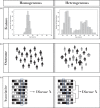Genetic heterogeneity: Challenges, impacts, and methods through an associative lens
- PMID: 35924480
- PMCID: PMC9669229
- DOI: 10.1002/gepi.22497
Genetic heterogeneity: Challenges, impacts, and methods through an associative lens
Abstract
Genetic heterogeneity describes the occurrence of the same or similar phenotypes through different genetic mechanisms in different individuals. Robustly characterizing and accounting for genetic heterogeneity is crucial to pursuing the goals of precision medicine, for discovering novel disease biomarkers, and for identifying targets for treatments. Failure to account for genetic heterogeneity may lead to missed associations and incorrect inferences. Thus, it is critical to review the impact of genetic heterogeneity on the design and analysis of population level genetic studies, aspects that are often overlooked in the literature. In this review, we first contextualize our approach to genetic heterogeneity by proposing a high-level categorization of heterogeneity into "feature," "outcome," and "associative" heterogeneity, drawing on perspectives from epidemiology and machine learning to illustrate distinctions between them. We highlight the unique nature of genetic heterogeneity as a heterogeneous pattern of association that warrants specific methodological considerations. We then focus on the challenges that preclude effective detection and characterization of genetic heterogeneity across a variety of epidemiological contexts. Finally, we discuss systems heterogeneity as an integrated approach to using genetic and other high-dimensional multi-omic data in complex disease research.
Keywords: GWAS; complex disease; genetic heterogeneity; precision medicine.
© 2022 The Authors. Genetic Epidemiology published by Wiley Periodicals LLC.
Figures


Similar articles
-
Biologically Relevant Heterogeneity: Metrics and Practical Insights.SLAS Discov. 2017 Mar;22(3):213-237. doi: 10.1177/2472555216682725. Epub 2017 Jan 6. SLAS Discov. 2017. PMID: 28231035 Free PMC article. Review.
-
Improving individual predictions: Machine learning approaches for detecting and attacking heterogeneity in schizophrenia (and other psychiatric diseases).Schizophr Res. 2019 Dec;214:34-42. doi: 10.1016/j.schres.2017.10.023. Epub 2017 Nov 1. Schizophr Res. 2019. PMID: 29074332 Review.
-
New insights from the widening homogeneity perspective to target intratumor heterogeneity.Cancer Commun (Lond). 2018 May 4;38(1):17. doi: 10.1186/s40880-018-0287-y. Cancer Commun (Lond). 2018. PMID: 29764517 Free PMC article. Review.
-
HPO2Vec+: Leveraging heterogeneous knowledge resources to enrich node embeddings for the Human Phenotype Ontology.J Biomed Inform. 2019 Aug;96:103246. doi: 10.1016/j.jbi.2019.103246. Epub 2019 Jun 27. J Biomed Inform. 2019. PMID: 31255713 Free PMC article.
-
Combining explainable machine learning, demographic and multi-omic data to inform precision medicine strategies for inflammatory bowel disease.PLoS One. 2022 Feb 23;17(2):e0263248. doi: 10.1371/journal.pone.0263248. eCollection 2022. PLoS One. 2022. PMID: 35196350 Free PMC article.
Cited by
-
Melorheostosis: A Systematic Review of Clinical Manifestations, Diagnostic Challenges, Therapeutic Strategies, and Physiotherapeutic Interventions.Cureus. 2025 Mar 11;17(3):e80407. doi: 10.7759/cureus.80407. eCollection 2025 Mar. Cureus. 2025. PMID: 40213745 Free PMC article. Review.
-
High resolution class I HLA-A, -B, and -C diversity in Eastern and Southern African populations.Sci Rep. 2025 Jul 2;15(1):23667. doi: 10.1038/s41598-025-06704-4. Sci Rep. 2025. PMID: 40603473 Free PMC article.
-
Prioritization of oligogenic variant combinations in whole exomes.Bioinformatics. 2024 Mar 29;40(4):btae184. doi: 10.1093/bioinformatics/btae184. Bioinformatics. 2024. PMID: 38603604 Free PMC article.
-
Oocyte and dietary supplements: a mini review.Front Cell Dev Biol. 2025 Jun 26;13:1619758. doi: 10.3389/fcell.2025.1619758. eCollection 2025. Front Cell Dev Biol. 2025. PMID: 40641606 Free PMC article. Review.
-
Heterogeneous genetic architectures of prostate cancer susceptibility in sub-Saharan Africa.Nat Genet. 2024 Oct;56(10):2093-2103. doi: 10.1038/s41588-024-01931-3. Epub 2024 Oct 2. Nat Genet. 2024. PMID: 39358599
References
-
- Albiñana, C. , Grove, J. , McGrath, J. J. , Agerbo, E. , Wray, N. R. , Bulik, C. M. , Nordentoft, M. , Hougaard, D. M. , Werge, T. , Børglum, A. D. , Mortensen, P. B. , Privé, F. , & Vilhjálmsson, B. J. (2021). Leveraging both individual‐level genetic data and GWAS summary statistics increases polygenic prediction. The American Journal of Human Genetics, 108(6), 1001–1011. - PMC - PubMed
-
- Altman, N. , & Krzywinski, M. (2015). Points of significance: Association, correlation and causation. Nature Methods, 12(10), 899–900. - PubMed
-
- Ashapkin, V. V. , Kutueva, L. I. , & Vanyushin, B. F. (2019). Epigenetic clock: Just a convenient marker or an active driver of aging? Reviews on Biomarker Studies in Aging and Anti‐Aging Research, 1178, 175–206. - PubMed
-
- Athey, S. , & Imbens, G. W. (2015). Machine learning methods for estimating heterogeneous causal effects. Stat, 1050(5), 1–26.
Publication types
MeSH terms
Grants and funding
LinkOut - more resources
Full Text Sources

